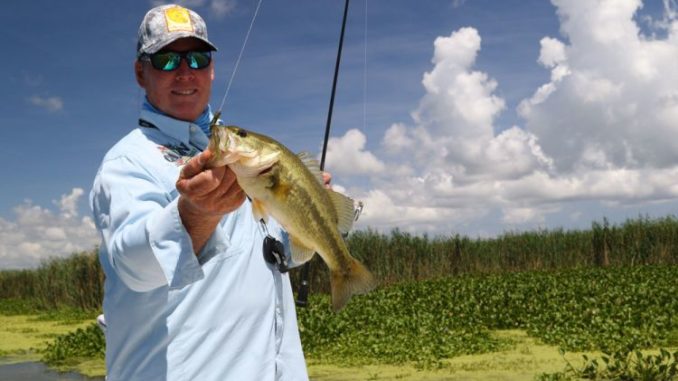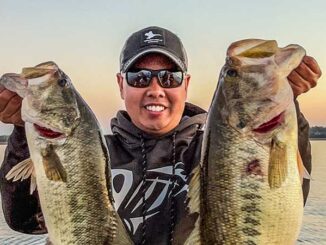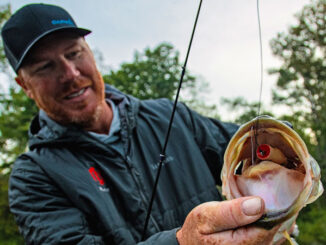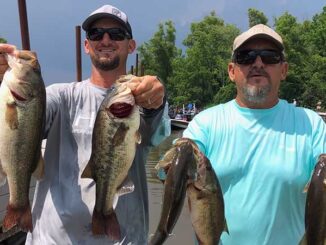
Louisiana’s coastal marshes offer a variety of hints and clues on where to target ‘green trout’ — the key is being able to interpret them.
With morning glories blooming across the canal, Capt. Cody Obiol was pushing away from the dock as I waited for his boss, Capt. Ryan Lambert to launch his Skeeter bay boat. Obiol was after bull reds that morning, but he knew my mission involved something much different, so his gracious salutation stoked my optimism.
“You gonna find some bass, Mr. David?” Obiol said. “You ought to be able to find some with this good river.”
Indeed, with the Mississippi falling, Obiol’s words of encouragement referred to the likely concentration of largemouth bass in predictable areas. The day’s light winds would help keep our spots clean, while the marring summer algae had been blown out by recent tropical weather.
Our mission would take us into areas known for what Lambert calls “Christmas fishing” — catching reds and bass in close proximity. We actually did just that, although in fractured form.
However, two days later, I joined Capt. Joe DiMarco for some marsh fishing a little closer to Buras and I watched Ricky Teschendorf snare a healthy largemouth from a grass edge with scattered Roseau cane just moments before Iiley Thompson nabbed a beautiful marsh pumpkin on a ChatterBait.
Something different
Lambert, who has made his living as a guide and lodge operator for nearly 40 years, mostly targets redfish, speckled trout and other saltwater species, but he’s a big fan of the Delta’s bass fishery. He never tires of the saltwater scene, but largemouth bass are his guilty pleasure. A couple of decades ago, Lambert competed in B.A.S.S. regional tournaments, but now, he enjoys a more relaxed pace that allows him to chase those Delta bass just for fun.
“The Delta’s largemouth bass action is incredible,” said Lambert, who opened Cajun Fishing Adventures in Buras in 1994. “Toledo Bend has always been great, but the local waters here (in Buras) where I cut my teeth will always be my favorite. And if you go down the Delta to Venice, that’s something special there — you can catch 100 fish a day. When the river is low, there’s no better fishery.”
Just ask Bassmaster Elite legend Kevin VanDam, who’s dominant victory at the 2011 Bassmaster Classic showcased the Delta’s incredible bass potential. Of course, Southeastern Louisiana is a dynamic region given to a roller coaster ride of natural and manmade water influences, but despite the ups and downs, the Delta marshes offer some straight-up legit bass fishing.
Both sides of the Delta play, too, as the labyrinth-like network of pipeline canals and natural bayous offer extensive avenues through which bass can navigate to their desired clarity and temperature levels. Add to this the expansive habitat features of weed-choked ponds, and you have a something-for-everyone scenario.
One of my personal favorite Delta memories was spending a morning wind-drifting a weed-choked lake in the Delacroix area. Targeting isolated patches of hyacinth, hydrilla edges and storm-blown wood yielded blow up after savage blow up on topwater frogs. I’m certain that pitching those scattered laydowns would’ve been productive, but it’s hard to leave a good frog bite.
Where to look
The only downside of Delta bass fishing is the timeless dilemma of where to start. No doubt, promising habitat seems endless, but defining clues exist for those who can interpret them.
“Watch your wheel wash when you run into an area,” DiMarco says. “If it’s foamier, it’s salty. If the bubbles disappear quickly, it’s more fresh.”
Indeed, largemouth cannot tolerate saltwater, so DiMarco was constantly monitoring wind direction to determine where the saltwater boundary was shifting. For example, too much wind blowing into one of his favorite canals prompted him to pull the plug and head elsewhere. In addition to water quality, DiMarco also checked out local hyacinth mats: bright and green indicated a freshwater area, while saltwater intrusion turned hyacinth mats a wilted brown.
Lambert pointed to indigenous vegetation for clear signs of Delta bass habitat. Cattails, American lotus pads and duck potato are some of the best signs he can see. A green, stalky plant that looks something like arrowheads, the latter also provided navigational reference in the often narrowing marsh waterways.
“Duck potato needs that fresh water; they grow on mud flats and sand flats,” DiMarco said. “If you read that shoreline, you can find out where a mud point is based on how far out those duck potatoes are growing. That also helps you with navigation so you don’t get stuck.”
Tides, of course, influence the marsh bass pursuits, as rising water opens the doors to all those drains and cuts and inner reaches; while falling water ushers fish out to the deeper boundaries. When the outgoing tide starts cranking, you’ll usually find Lambert hugging the Roseau cane or cattail lines, where he flips into the little hidey spots where bass like to sit. You’ll also want to pay attention to the hyacinth mats that float with the tide, often jamming into little corners of shoreline contours.
Another tidal factor DiMarco favored are the countless drains (“trenasses”), which offer falling tide ambush points. As he explained, bass will sit on the outside edges of these openings and pick off current-carried meals. Moreover, since marshes filter water, the falling tide sends a cleaner plume into adjacent channels. Baitfish tend to cluster in such areas, thereby attracting more bass.
What works
More than a dozen times, Lambert and I both tried to set the hook, only to feel our lines go slack, as the shadow of a worm-tugging bream scurried back to the Roseau roots. This should clue you in to the applicability of bream-mimicking baits like a Jackall Clone Gill, LIVETARGET Sunfish, or a swim jig with touches of purple and orange in a green pumpkin skirt.
Typically, DiMarco and Lambert both like pitching jigs with craw trailers or Texas-rigged craws with enough weight to push through hyacinth and moderate density vegetation. Idling along a bayou or a pipeline canal, you’ll want to hit all the points, cuts and visible wood, while keeping watch for telltale signs like boils, busts and showering bait schools.
Other productive baits for low-tide bass include spinnerbaits, Chatterbaits and finesse worms. Bass in the Delta marshes eat a lot of the fiddler crabs, so hopping a Ned rig (short stick worm on a mushroom style jighead) looks a lot like small crustaceans running for cover.
For just about any shallow bass scenario where you’re working defined edges, a weedless-rigged 5- to 6-inch stick bait packs a lot of versatility. You can skip it under willow trees, crawl it across weed mats, pitch it to specific targets, twitch it through interesting areas and dead stick it in key spots like holes in the grass patches flanking main vegetation line.
In shallow areas, especially in clear water, casting distance is critical. A good choice here is a nail-weight in your stick worm — essentially, a Neko rig. Another option is a weighted shank hook like Mustad’s UltraPoint weighted Grip Pin. For swimming presentations, consider an articulated head like the TT Lures SnakeLockZ. Use the Grip Pin or the SnakeLockZ with your stick worms or the ZMan SwimmerZ that DiMarco often uses for marsh bass.
Considering that Delta largemouth eat a lot of shrimp, you’ll want to keep a selection of these artificials handy. Free-line the bait parallel to the edge of draining vegetation and target any run-outs you find. To boost the appeal and secure the ability to hover a bait in a likely area, Lambert suspends a LiveTarget Rigged Shrimp below a popping cork and works it with the tide.
Don’t forget to check the various pumping stations scattered throughout the marsh, especially those with docking platforms. Pitch a jig or Texas-rigged worm, lizard or craw bait around the legs or, if sufficient clearance allows, pitch a bait back into the shadows. Another good bet: A wacky-rigged Senko fluttering along the shadow line can be money.
With any marsh bass offering, the dense vegetation common to this fertile region, compounded by frequent encounters with party crashing redfish, makes braided line a must. Fluorocarbon leaders help prevent bass spooking, but the Delta marsh guards its treasures well, so make sure you’re properly tooled for the task.


